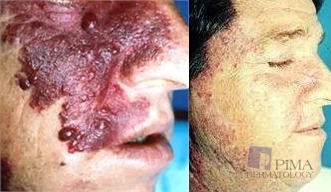Causes: Unknown

Condition Overview
Red or burgundy patch on the skin which slowly darkens and thickens in the first several decades of life which may develop localized thickenings (blebs) which can bleed, or become infected. Unlike Hemangiomas, Port-Wine Stains grow proportionately as the child grows. PWS do not go away by themselves, and will thicken, darken and lead to deformity without treatment.
Symptoms
Thickened, red/purple or burgundy colored papules over the Port-Wine Stain which may bleed; red/purple facial stain may be associated with seizures, glaucoma, and intellectual and developmental disabilities (Sturge Weber Syndrome).
Treatments
The Pulsed Dye Laser (Candela Perfecta Laser) is the "Gold Standard" for Port Wine Stain (PWS) treatment and offers several distinctive advantages over other systems. It was specially designed for treatment of the PWS, and for other skin lesions with prominent red blood vessels. This Laser can often be used without anesthesia, has a very low risk of scarring, and is safe and effective for use in infants, children and adults.
The Vbeam Perfecta comes equipped with a synchronized dynamic cooling device to protect the skin surface so that higher energies can be delivered to the skin safely and also to minimize pain with treatment. In addition, this Laser has the capacity to deliver longer pulses to allow the energy more effectively to heat and destroy larger vessel targets and also to treat the skin without bruising. The Vbeam has a slightly longer wavelength as well as larger spot sizes, which allow deeper Laser penetration with higher energies to more effectively remove and lighten the vessel targets.
Procedure Overview
A brief, bright flash of light occurs and the skin site treated will immediately develop a purple spot about a 1/2 inch in diameter. The skin stings for a few seconds as if snapped by a rubber band, and will itch for several minutes. The purple spots will last for 7 to 10 days. The spots treated become increasingly red for 10 more days. At about one month, the treated site begins to fade and will continue to lighten for 2 to 3, months after which clearing can be seen and evaluated.
In most cases, depending on the size of the lesion, the entire lesion can be treated at each visit. Most treatment sessions last 15-30 minutes which is usually sufficient time to treat a palm sized area or greater depending on lesion location and patient cooperation.
Pre / Post Treatment
It is essential that the skin over the PWS to be treated be as pale as possible prior to treatment. Broad-spectrum Sunscreens (SPF 30 or higher) need to be applied routinely before and after therapy. Postoperative care is simple and requires that you not rub or create any friction over the area. The treated area should be cleaned with gentle soap and water followed with the application of an antibacterial ointment such as Polysporin ointment two to three times daily for the first seven to ten days after therapy.
